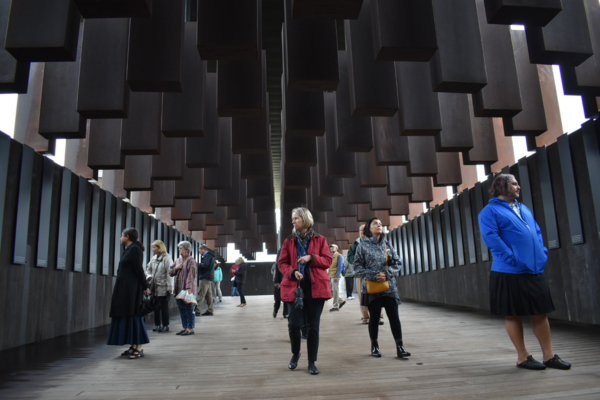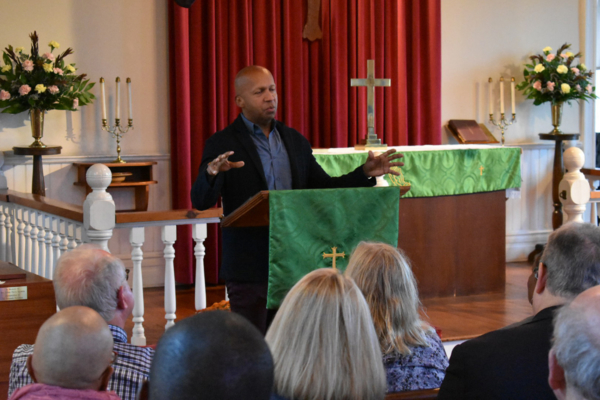Southwest Florida Episcopalians lead efforts to remember victim of 1914 lynching in St. PetersburgPosted Feb 12, 2020 |
|

The Alabama-based Equal Justice Initiative founded the National Memorial for Peace and Justice in April 2018 and encouraged counties around the country to pursue local memorials for the victims of lynchings in their communities. The Episcopal Church’s Executive Council visited the memorial in Montgomery, Alabama, during its October 2019 meeting there. Photo: David Paulsen/Episcopal News Service
[Episcopal News Service] The National Memorial for Peace and Justice in Montgomery, Alabama, which opened two years ago to honor more than 4,000 victims of lynchings in America, has become a popular destination for Episcopal racial reconciliation pilgrimages. Numerous congregations have organized trips, and The Episcopal Church’s Executive Council visited the memorial in October 2019 during its meeting in Montgomery.
The Equal Justice Initiative, which created the national memorial, also has a program to encourage local efforts to increase the public’s awareness of what the organization labels racial terror violence during the era of Jim Crow segregation. Parishioners from St. Augustine’s Episcopal Church in St. Petersburg, Florida, are taking that next step.
“We were all moved by it, and a group of us decided we would take on this project,” said Jacqueline Hubbard, a St. Augustine’s member and retired lawyer.
St. Augustine’s is a small, historically black congregation that has gradually grown more racially diverse. Its fall 2018 visit to the National Memorial for Peace and Justice partly inspired some parishioners’ involvement in efforts to install a historical marker in St. Petersburg that will memorialize John Evans, a black laborer who in 1914 was hanged from a light pole in the city and murdered, as a mob of 1,500 white residents encouraged and celebrated his death.
Reports suggest he was able to keep himself alive by wrapping his legs around the light pole, until he was shot by people in the crowd. He had been accused by the crowd of killing a white employer despite little conclusive evidence tying him to the crime.
“In many cases these individuals were not given or allowed to experience a proper memorial,” vestry member Andrew Walker said in an interview with Episcopal News Service, adding, “the current narrative in a lot of places is a false notion that [lynching victims] did something wrong.”
A small group from the church formed the Community Remembrance Project Coalition in April 2019, and it now has 42 coalition partners, including a wide range of religious, historical and civic organizations. It meets twice a month at St. Augustine’s to plan a historical marker for Evans.
Hubbard, who serves as co-chair, told ENS the coalition aims to install the marker by this November on city-owned property at Ninth Street and Second Avenue, near where Evans was lynched on Nov. 12, 1914.

Bryan Stevenson of the Equal Justice Initiative speaks to the Executive Council members on Oct. 19, 2019, at Church of the Good Shepherd in Montgomery, Alabama. Photo: David Paulsen/Episcopal News Service
The killing of Evans was one of at least two lynchings in Pinellas County from 1877 to 1950, according to Equal Justice Initiative research. The nonprofit was founded by attorney Bryan Stevenson, whose book “Just Mercy” was turned into the movie of the same name released in December. Stevenson’s organization documented more than 4,400 lynchings in 12 Southern states during those decades, and another 300 victims were identified in states outside the South.
“Terror lynchings were horrific acts of violence whose perpetrators were never held accountable. Indeed, some public spectacle lynchings were attended by the entire white community and conducted as celebratory acts of racial control and domination,” the Equal Justice Initiative’s research report “Lynching in America” says.
Even before the recent work by St. Augustine’s parishioners, Episcopal leaders have taken a lead in bringing details of this brutal history to light, particularly in the Diocese of Atlanta. The diocese organized a pilgrimage in October 2016 to the historic site of a lynching in Macon, Georgia, part of a three-year series of racial reconciliation events. And in 2017, St. Mark’s Episcopal Church in LaGrange, Georgia, supported local efforts to dedicate a historical marker remembering lynching victims.
Also in 2017, the Diocese of Tennessee held a Eucharistic service and memorial litany for three identified victims of lynchings in Davidson County and for others whose identities are lost to history. A memorial marker was dedicated at St. Anselm’s Episcopal Church in Nashville.
Such efforts coincide with The Episcopal Church’s setting racial reconciliation as a top priority in recent years, and that work gathered steam last week when the Diocese of Texas announced it was committing $13 million to racial justice projects and promotion of racial healing.
The Equal Justice Initiative has been building momentum in its campaign to tell the fuller story of the United States’ legacy of racial injustice, violence and oppression. Its national prominence surged with the opening in April 2018 of the National Memorial for Peace and Justice. On a hill overlooking downtown Montgomery, the memorial’s series of steel columns hang in rows around a green square. Each column represents a county where the Equal Justice Initiative has confirmed at least one lynching occurred. The victims are listed on the columns.
“It is powerful when you see every county in the United States where lynchings occurred,” said Walker, who first visited the memorial soon after it opened.
In addition to the two lynchings the Equal Justice Initiative confirmed in Pinellas County, Hubbard said the coalition is investigating evidence of one or two possible others.
The coalition has budgeted about $25,000 for the project, with hopes that a pending donation will cover most of that cost. The coalition also is requesting about $10,000 from the Equal Justice Initiative, partly to support a high school essay contest on racial justice. The nonprofit has engaged in similar collaborations with other communities, from Selma, Alabama, to Wilmington, Delaware.
“They’re committed to community development strategies and coalition strategies, to avoid conflict in doing this kind of work, because it is powerful work and it is challenging work,” Walker said.
The Equal Justice Initiative also created duplicate columns at its memorial in Montgomery, one for each of the more than 800 counties, and it has invited each county to claim and display its column as an act of confronting, acknowledging and remembering its history.
Few counties have done so yet, but Hubbard said that is one possible next step for the St. Petersburg coalition, after it installs the Evans marker.
– David Paulsen is an editor and reporter for Episcopal News Service. He can be reached at dpaulsen@episcopalchurch.org.

Social Menu